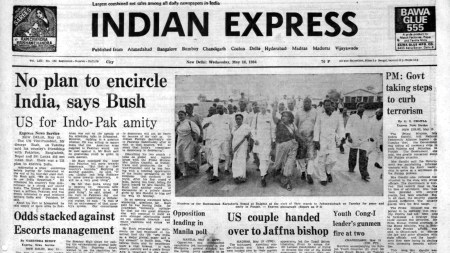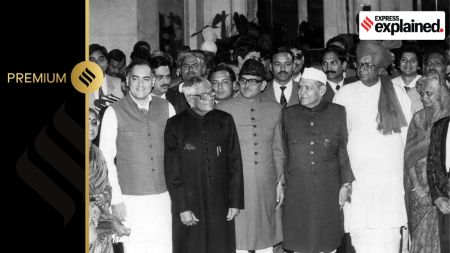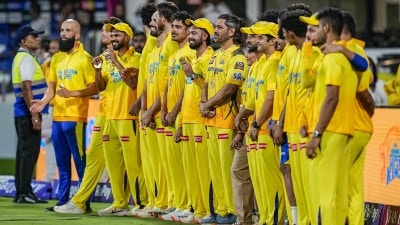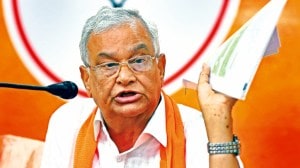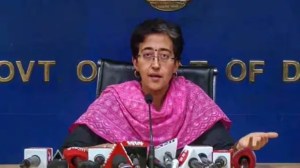- India
- International
UPSC Essentials | Mains answer practice — GS 1 Questions on Battle of Plassey and hydropower (Week 49)
Are you preparing for UPSC CSE 2024? Here are questions from GS paper 1 for this week with essential points as the fodder for your answers. Do not miss points to ponder and answer in the comment box below. Try them out
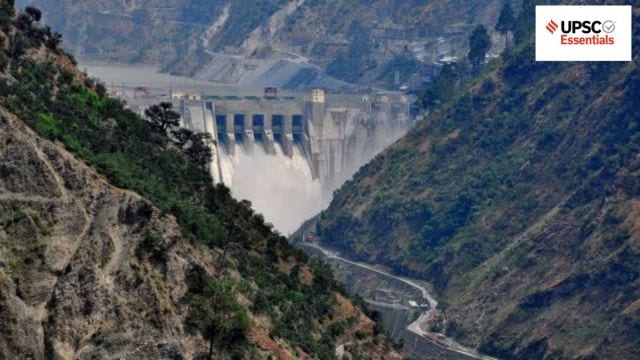 The Baglihar dam, on the Chenab, in J&K. Attempt question on hydropower electricity in today's answer writing. (Credit: CIMOD/Representative)
The Baglihar dam, on the Chenab, in J&K. Attempt question on hydropower electricity in today's answer writing. (Credit: CIMOD/Representative)UPSC Essentials brings to you its initiative for the practice of Mains answer writing. It covers essential topics of static and dynamic parts of the UPSC Civil Services syllabus covered under various GS papers. This answer-writing practice is designed to help you as a value addition to your UPSC CSE Mains. Attempt today’s answer writing on questions related to topics of GS-1 to check your progress.
🚨 The Indian Express UPSC Essentials brings to you the April edition of its monthly magazine. Click Here to read. Share your views and suggestions in the comment box or at manas.srivastava@indianexpress.com🚨
QUESTION 1
A battle fought between the British and the Nawab of Bengal, Siraj-ud-Daulah, on the banks of the Hooghly River marked a watershed moment in modern Indian history. Discuss.
QUESTION 2
How viable are low-carbon renewables in an increasingly hot and arid world?
General points on the structure of the answers
Introduction
— The introduction of the answer is essential and should be restricted to 3-5 lines. Remember, a one-liner is not a standard introduction.
— It may consist of basic information by giving some definitions from the trusted source and authentic facts.
Body

You may incorporate some of the following points in the body of your answer:
— It is the central part of the answer and one should understand the demand of the question to provide rich content.
— The answer must be preferably written as a mix of points and short paragraphs rather than using long paragraphs or just points.
— Using facts from authentic government sources makes your answer more comprehensive. Analysis is important based on the demand of the question, but do not over analyse.
— Underlining keywords gives you an edge over other candidates and enhances presentation of the answer.
— Using flowcharts/tree-diagram in the answers saves much time and boosts your score. However, it should be used logically and only where it is required.
Way forward/ conclusion
— The ending of the answer should be on a positive note and it should have a forward-looking approach. However, if you feel that an important problem must be highlighted, you may add it in your conclusion. Try not to repeat any point from body or introduction.
— You may use the findings of reports or surveys conducted at national and international levels, quotes etc. in your answers.
Self Evaluation
— It is the most important part of our Mains answer writing practice. UPSC Essentials will provide some guiding points or ideas as a thought process that will help you to evaluate your answers.
THOUGHT PROCESS
You may enrich your answers by some of the following points
QUESTION 1: A battle fought between the British and the Nawab of Bengal, Siraj-ud-Daulah, on the banks of the Hooghly River marked a watershed moment in modern Indian history. Discuss.
Introduction:
— The Battle of Plassey is remembered in historical imagination, as well as cultural and literary depictions, as the moment when the British took control of the Indian subcontinent.
— The dispute reached a climax in 1756, when 23-year-old Siraj-ud-Daulah ascended to the throne. While Alivardi Khan’s reign was dubbed the ‘golden age’ of the province, his grandson Siraj-ud-Daulah was despised by practically the entire Murshidabad court.
— The Battle of Plassey became renowned because it marked the Company’s first important success in India.
Body:
You may incorporate some of the following points in the body of your answer:
— Following the defeat at Plassey, Sirajuddaulah was slain, and Mir Jafar became the nawab. The company was still unwilling to take on administrative responsibilities.
— Its primary goal was the expansion of trade. If this could be accomplished without conquering, with the assistance of local rulers ready to award privileges, regions would not need to be taken over directly.
— When Mir Jafar complained, the Company removed him and installed Mir Qasim as his replacement. When Mir Qasim complained, he was defeated in a battle at Buxar (1764), driven out of Bengal, and Mir Jafar was reinstated.
— The Nawab had to pay Rs 500,000 every month, but the Company sought more money to fund its battles, meet trade demands, and cover other expenses. It sought more territories and revenue.
— Finally, in 1765, the Mughal emperor designated the Company as Diwan of Bengal.
— The Diwani enabled the Company to leverage Bengal’s large revenue resources, resolving a major issue that the Company had previously faced.
— The outflow of gold from Britain slowed following the Battle of Plassey and came to a halt with Diwani’s ascension. Revenues from India can now be used to fund company expenses. These funds could be used to buy cotton and silk textiles in India, support Company troops, and pay for the construction of the Company fort and offices in Calcutta.
(Source: How Mir Jafar became India’s ultimate ‘traitor’, and Siraj-ud-Daulah a patriot by Adrija Roychowdhury, ncert.nic.in)
Points to Ponder
Battle of Buxar
Conflict between the Company and the Nawabs of Bengal
Related Previous Year Questions
Explain how the upraising of 1857 constitutes an important watershed in the evolution of British policies towards colonial India. (2016)
The third battle of Panipat was fought in 1761. Why were so many empire-shaking battles fought at Panipat? (2014)
QUESTION 2: How viable are low-carbon renewables in an increasingly hot and arid world?
Introduction:
— India aims to achieve GHG neutrality, or Net Zero, by 2070 through its nationally determined contributions (NDCs) to the Paris Pact.
— Since its inception over a century ago, hydropower has shown to be a dependable, cost-effective, and low-carbon energy source. It presently generates more electricity than all other renewable energy sources combined.
— Hydropower works by harnessing the flow of water via a turbine, which generates energy as it rotates.
Body:
You may incorporate some of the following points in the body of your answer:
— According to Ember, a UK-based energy think tank, hydropower is the world’s largest renewable source of electricity and has increased by 70% over the last two decades. However, in the first half of 2023, its global output suffered a historic decrease.
— China, the world’s greatest hydroelectricity generator, was responsible for three-quarters of the global reduction. Droughts in 2022 and 2023 caused Chinese rivers and reservoirs to dry up, resulting in power shortages and forcing the government to ration electricity.
— According to the data, drought, which was most likely exacerbated by climate change, caused an 8.5% decline in global hydroelectricity during this time period.
— Countries that rely heavily on hydropower are particularly vulnerable to climate consequences. For example, hydropower generates more than 80% of electricity in the Democratic Republic of the Congo, Ethiopia, Malawi, Mozambique, Uganda, and Zambia, all of which are experiencing severe droughts.
— The solution for these countries is to diversify their energy sources by embracing other renewable technologies like wind and solar.
Conclusion:
— Despite the climatic dangers associated with the technology, many believe it will continue to play an important part in decarbonising the global economy.
— Building more medium-scale facilities, rather than megadams, would assist to alleviate the climatic risks associated with relying on a single large piece of infrastructure.
— The International Energy Agency expects that hydropower will eventually be surpassed by wind and solar, although it will remain the world’s greatest source of renewable electricity generation until the 2030s.
(Source: What is the role of hydropower in a world facing increasing drought?)
Points to Ponder
Solar and wind energy
Solar installations in India
Hydropower plants in news
Related Previous Year Questions
Examine the potential of wind energy in India and explain the reasons for their limited spatial spread. (2022)
India has immense potential of solar energy though there are regional variations in its developments. Elaborate. (2019)
Previous Mains Answer Practice
UPSC Essentials: Mains answer practice — GS 1 (Week 47)
UPSC Essentials: Mains answer practice — GS 1 (Week 48)
UPSC Essentials: Mains answer practice — GS 2 (Week 48)
UPSC Essentials: Mains answer practice — GS 2 (Week 49)
UPSC Essentials: Mains answer practice — GS 3 (Week 49)
UPSC Essentials: Mains answer practice — GS 3 (Week 48)
Subscribe to our UPSC newsletter and stay updated with the news cues from the past week.
May 18: Latest News
- 01
- 02
- 03
- 04
- 05



